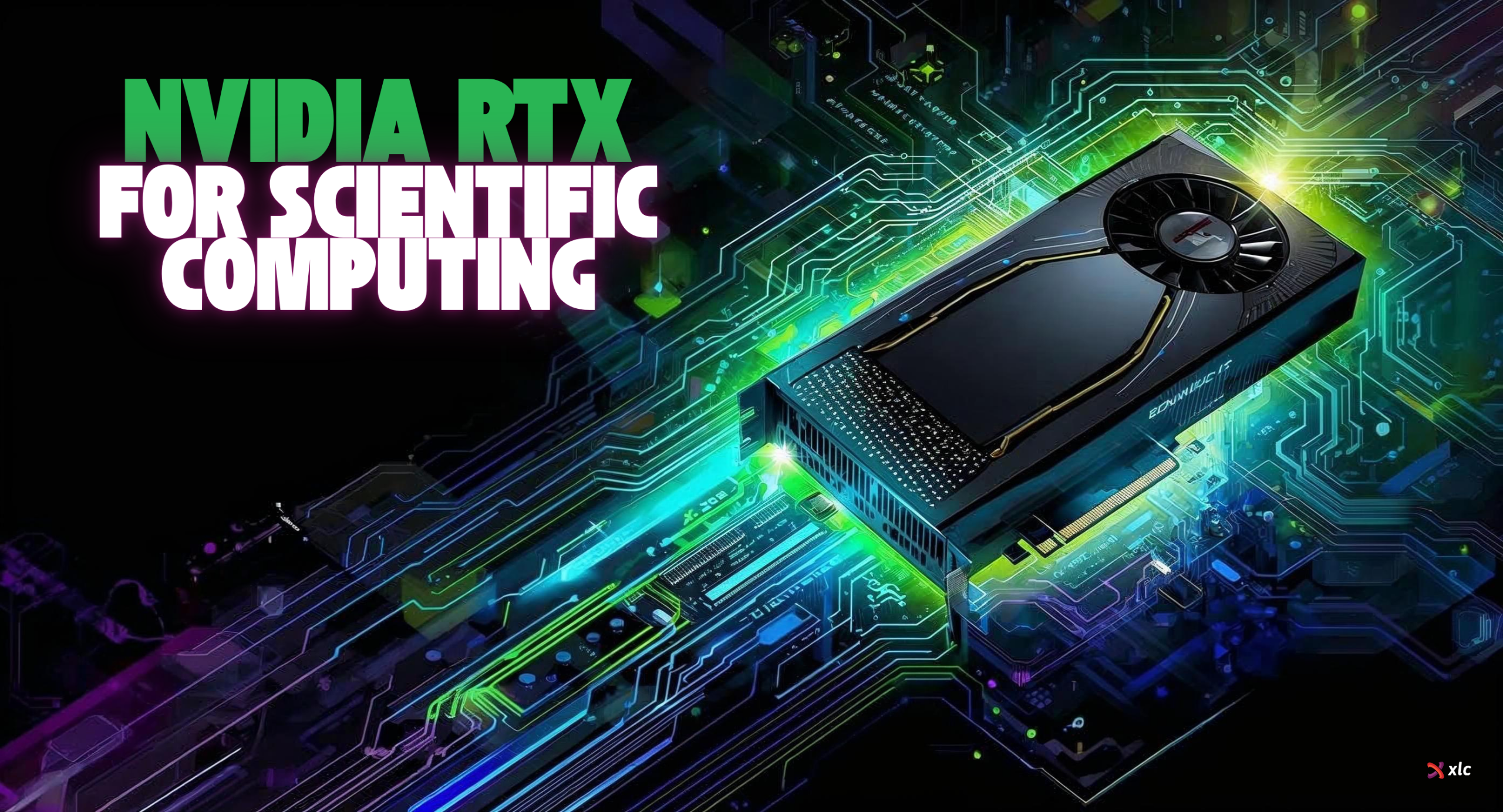
The rapid expansion of fields like scientific research, data analytics, and artificial intelligence is reshaping the requirements for computational infrastructure. Traditional CPU-based systems often struggle to keep up with workloads demanding both large-scale processing and speed. In recent years, NVIDIA RTX GPUs have become a popular option for those looking to accelerate high-performance computing (HPC), thanks to their parallel processing abilities, advanced memory architecture, and AI-optimized cores. This article examines how NVIDIA RTX can be effectively used for HPC and AI workloads, offers guidance on configuring GPU servers, and explains how platforms such as XLC can support demanding projects.
NVIDIA RTX: Consumer GPU, Enterprise Potential
It’s important to note that NVIDIA RTX belongs to the consumer GPU category. While not designed to replace high-end enterprise GPUs—which can cost upwards of $30,000 each—RTX GPUs offer a cost-effective alternative for individuals, small businesses, and organizations seeking access to AI and machine learning computing power. For many, RTX GPUs serve as a practical substitute that provides much of the parallel processing capability needed for research, prototyping, and even some production workloads, without the significant financial commitment of enterprise-grade hardware.
Why Parallelism Matters in Modern HPC
Today’s complex workloads—such as molecular dynamics simulations, training of large language models, or 3D rendering—require the ability to process trillions of operations per second. Here, GPUs, with their ability to perform massively parallel computations, have become essential. NVIDIA’s RTX lineup features CUDA cores for general processing, Tensor cores for AI, and RT cores for ray tracing, making them versatile for a range of applications.
Configuring Your NVIDIA RTX GPU Server
To maximize the benefits of NVIDIA RTX in HPC or AI, careful server configuration is key:
- GPU (e.g., RTX 4090): Handles parallel computation, with up to 48GB VRAM and support for multiple GPUs.
- CPU (e.g., AMD EPYC, Xeon): Manages data flow and prevents bottlenecks.
- RAM (ECC DDR4/DDR5): Supports large datasets and minimizes errors.
- Storage (NVMe SSD): Provides fast data access and efficient model checkpointing.
- Network (10G+): Enables distributed training and fast data transfer.
Tip: Ensure your GPU memory is sufficient for your model or dataset size to avoid bottlenecks.
Sample XLC GPU Server Configurations
| Model | CPU(s) | RAM | Storage | GPU | Max GPUs | Price (USD/mo) |
| AMD EPYC 24 Cores | 1 x 7402P | 64GB DDR4 | 960GB NVMe | 1 x RTX 4090 48GB | 4 | $559 |
| AMD EPYC 64 Cores | 1 x 7B13 | 64GB DDR4 | 960GB NVMe | 1 x RTX 4090 48GB | 4 | $599 |
| AMD EPYC 32 Cores | 2 x 7313 | 128GB DDR4 | 960GB NVMe | 1 x RTX 4090 48GB | 8 | $809 |
| AMD EPYC 128 Cores | 2 x 7B13 | 128GB DDR4 | 960GB NVMe | 1 x RTX 4090 48GB | 8 | $879 |
Comparing CPU and GPU Servers for HPC
| Feature | CPU Server | GPU Server (RTX) |
| Processing Type | Sequential | Massively Parallel |
| AI/ML Training Speed | Moderate | 10x-50x faster |
| Deep Learning Support | Limited | Optimized (CUDA, TensorFlow, PyTorch) |
| Memory Bandwidth | Standard | High |
| Scalability | Limited | Multi-GPU, Cluster |
| Energy Efficiency | Lower | Higher |
Practical Applications of NVIDIA RTX in HPC
- Scientific Research: Accelerate climate models, molecular analysis, and genomics.
- Healthcare: Speed up imaging, genome sequencing, and drug discovery.
- Finance: Enhance real-time risk modeling and fraud detection.
- Engineering and Manufacturing: Support digital simulations and advanced robotics.
- Media and Entertainment: Enable high-resolution rendering and real-time video processing.
- Autonomous Systems: Power real-time data fusion and path planning.
Tip: Dedicated RTX GPU servers can offer the flexibility and throughput needed for projects like computer vision, language modeling, or time-sensitive simulations.
Operational Benefits with XLC GPU Infrastructure
XLC offers a platform supporting NVIDIA RTX GPU servers with features such as:
- Global Connectivity: Low latency through Tier 1 carrier networks and major APAC peering.
- Redundancy and Uptime: Dual power feeds and N+1 cooling help ensure operational stability.
- Compliance: Data centers certified to ISO 27001, SOC2, and PCI DSS standards.
- Security: DDoS protection and 24/7 network monitoring safeguard workloads.
Choosing the Right GPU Server Configuration
- Assess your workload to determine the right balance of CPU, GPU, RAM, and storage.
- Match GPU VRAM to your expected model/data size.
- Ensure the platform supports your preferred AI/ML frameworks.
- Use ECC RAM for critical computations.
- Consider NVMe SSDs and high-speed networking for data-intensive tasks.
Frequently Asked Questions:
NVIDIA RTX for HPCWhy use NVIDIA RTX for HPC tasks?
RTX GPUs deliver strong parallel computing capabilities suitable for deep learning, analytics, and simulations—making them a practical alternative for many research and AI projects.
How quickly can XLC deploy a dedicated RTX GPU server?
Most standard server configurations can be provisioned within an hour.
Does XLC provide security and compliance for sensitive data?
Yes. XLC’s data centers meet strict compliance requirements and provide advanced DDoS and network protection.
Can infrastructure be scaled as project needs change?
XLC offers flexible configurations and cluster-ready options to adapt as your workload evolves.
How do I choose the right RTX GPU model?
Selection depends on the complexity of your workload, dataset size, and software requirements. XLC’s technical experts can help recommend the best fit.Tip: Benchmark your workload on a test server before scaling up to ensure cost efficiency and optimal resource use.
Conclusion: NVIDIA RTX as a Practical Solution for HPC
NVIDIA RTX GPUs have made high-performance computing more accessible, providing a practical and cost-effective way for the general public and research teams to explore AI, machine learning, and advanced analytics. While RTX is not a direct replacement for enterprise-grade GPUs, it offers a valuable substitute for many demanding workloads. With dedicated server solutions from providers like XLC, organizations can access the resources needed for scientific, financial, and creative projects—without the high costs associated with enterprise hardware. As the demand for flexible and efficient compute platforms grows, NVIDIA RTX continues to play a pivotal role in democratizing access to advanced HPC capabilities.
